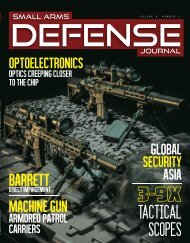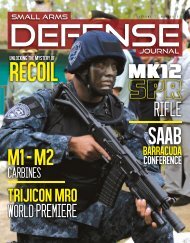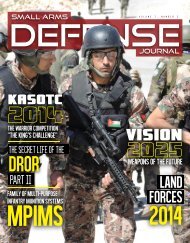SAR 18#6
You also want an ePaper? Increase the reach of your titles
YUMPU automatically turns print PDFs into web optimized ePapers that Google loves.
Top: The middle finger is used to press the trigger.<br />
Bottom: The pistol can be fired without the magazine inserted into the weapon.<br />
produced of standard ordinance grade steel that is 130 mm<br />
long and 32 mm in diameter. The barrel is threaded and<br />
screwed into the recess of the receiver. The barrel is quite short<br />
being 50 mm long and has fifteen holes evenly drilled around<br />
the diameter of the barrel. The only part that extends from the<br />
receiver is the threaded part of the barrel that is about 10mm<br />
in length. This barrel design will ensure that the gas pressure<br />
of a standard velocity 9mm projectile is reduced to below 300<br />
meters per second. The reason for this configuration is quite<br />
simple: it will ensure that the operator will not be dependent<br />
on subsonic ammunition to achieve the maximum results<br />
regarding noise.<br />
The locking system is somewhat like a bolt action rifle. It<br />
has two locking lugs not unlike a standard Mauser system. The<br />
locking lugs each have 30 mm² area. To unlock the system,<br />
take the bolt head at the end of the weapon between the thumb<br />
and index finger and turn the lock 90 degrees to the left. Then<br />
pull the bolt to the rear until the action is open. To load the<br />
weapon for the next shot, simply push the bolt closed and turn<br />
the bolt head 90 degrees to the right to lock the bolt in battery.<br />
A fresh cartridge will be fed from the magazine and chambered<br />
as the bolt closes. There is a red line on the top of the bolt and<br />
receiver that should be lined up. Repeat the process to eject<br />
the spent case and to reload a fresh round.<br />
The magazine functions as the handle grip of the<br />
weapon. This feeding device has a molded handgrip applied<br />
directly onto the magazine. The extension that the magazine<br />
fits into extends 28 mm below the contour of the receiver.<br />
This extension could be called the trigger assembly as the<br />
trigger feeds into it as well. It also contains the magazine<br />
release and safety. The safety is activated by pushing the knob<br />
from left to right.<br />
The Magazine<br />
One of the design considerations of the weapon application<br />
was that it be as compact as possible. To fill this requirement,<br />
B&T has utilized the single-row magazine of the SIG<br />
P225; though this magazine has been modified to accept a<br />
capacity of only 5 rounds. This plus one in the chamber gives<br />
the operator 6 rounds in total. The magazine is further modified<br />
by having a polymer grip shroud that functions as a grip. Standard<br />
P225 magazines without the shroud cannot be used. The<br />
operator can see how many rounds are left in the magazine by<br />
observing the holes on the side. Height of the weapon with the<br />
magazine inserted is just shy of 114 mm. The height minus the<br />
magazine is only 63 mm. The weapon can be fired without the<br />
magazine inserted.<br />
The Accessories<br />
It can be expected that the weapon could be used during<br />
hours of darkness or at least at twilight. It is for this reason<br />
that the VP9 has a NATO Accessory Rail that can be mounted<br />
on the tube of the suppressor. This will enable the operator to<br />
mount either a light or a laser or combination of both. There<br />
is also a rather nice transportation box made of leather which<br />
is more like an attaché case. Inside, the foam is cut out for all<br />
the accessories. There is another bag that that can be worn<br />
over the shoulder or around the waist. There is a flap at the<br />
www.smallarmsreview.com 47 <strong>SAR</strong> Vol. 18, No. 6









